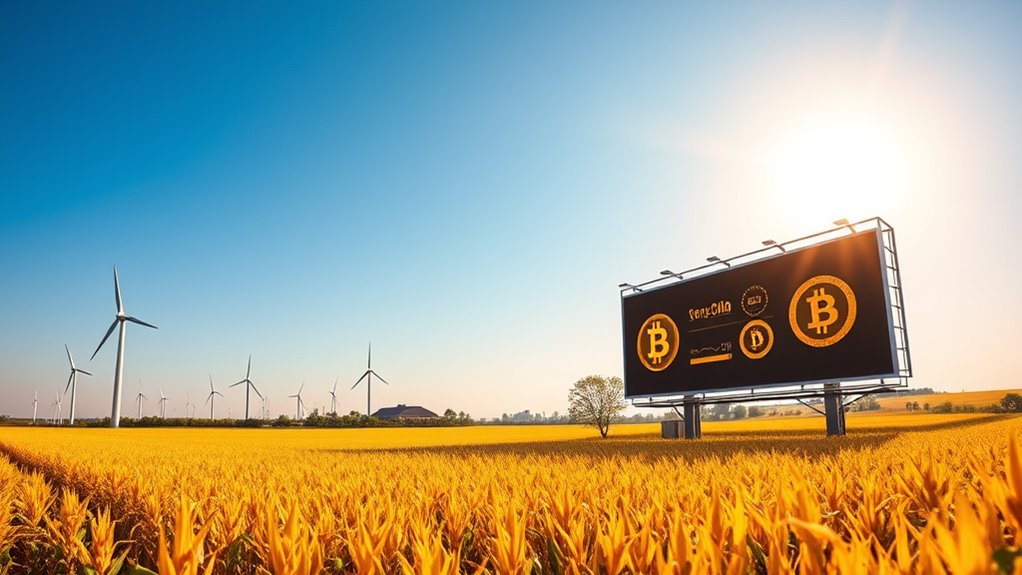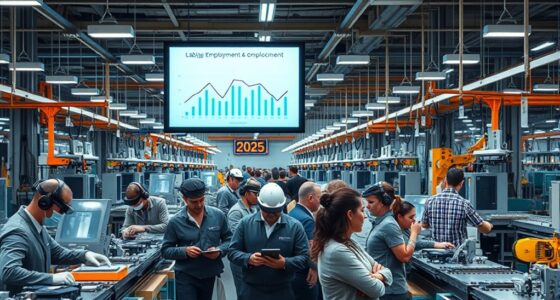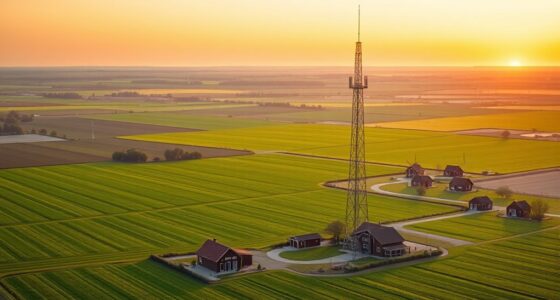Midwestern states are shifting from traditional agriculture to diversify their economies by investing in renewable energy, like wind and solar power, and supporting fast-growing tech startups. They’re repositioning as leaders in clean energy and innovation, attracting new industries and creating jobs. This strategy reduces dependence on fluctuating markets and helps build resilient communities. If you’re curious about how these regions are transforming their economic landscape, there’s more to uncover below.
Key Takeaways
- Midwest states are shifting focus from agriculture to emerging industries like renewable energy and technology startups.
- Investment in wind and solar power is reducing reliance on traditional fossil fuels.
- Cities such as Chicago and Minneapolis are becoming innovation hubs for tech and health tech startups.
- Regional collaborations among universities, businesses, and government foster a thriving entrepreneurial ecosystem.
- Infrastructure modernization supports renewable energy growth and attracts new high-tech industries.

Many Midwestern states are recognizing the need to diversify their economies to guarantee long-term stability and growth. Traditionally known for agriculture and manufacturing, these states now realize that relying solely on these sectors can be risky amid fluctuating markets and changing technologies. As a result, they’re making strategic moves to expand into emerging industries, particularly renewable energy and tech startups, to build more resilient economic foundations.
You’ll find that renewable energy is gaining significant traction across the Midwest. States like Iowa, Kansas, and Nebraska are investing heavily in wind power, capitalizing on their vast open spaces and strong wind resources. These investments not only help reduce dependence on fossil fuels but also create new job opportunities and attract clean energy companies. Solar energy projects are also emerging, especially as costs drop and technology improves. This shift toward renewable energy isn’t just about sustainability; it’s about positioning the Midwest as a key player in the clean energy economy, which can generate long-term economic benefits and energy independence. Additionally, developing a robust energy infrastructure is vital for supporting these industries and ensuring reliable power supply for future growth. Building a resilient energy grid is essential to accommodate the increased demand and integration of renewable sources, which is a crucial aspect of modernizing regional infrastructure.
At the same time, the region’s burgeoning tech startup scene is transforming traditional perceptions of the Midwest. Cities like Chicago, Minneapolis, and Kansas City are becoming hubs for innovation, drawing entrepreneurs and investors interested in everything from software development to health tech. These startups are often leveraging local strengths—such as agricultural data analytics or manufacturing automation—to develop innovative solutions that can compete nationally and globally. Supporting these startups through local funding, incubators, and favorable policies helps create a vibrant ecosystem where new ideas can flourish, diversify employment opportunities, and foster economic resilience. Furthermore, fostering a strong entrepreneurship ecosystem is essential for sustaining this growth and attracting talent. Encouraging collaboration between universities, businesses, and government initiatives can further accelerate this development, ensuring a sustainable pipeline of innovation.
Frequently Asked Questions
How Do Midwestern States Attract High-Tech Companies?
You can attract high-tech companies by developing vibrant tech hubs and nurturing startup ecosystems. Midwestern states offer affordable living costs, which appeal to entrepreneurs and employees alike. They also invest in modern infrastructure, provide tax incentives, and foster partnerships between universities and industry. By creating an environment where innovation thrives and startups can grow, these states make themselves attractive destinations for high-tech companies seeking to expand and succeed.
What Incentives Support New Industries in the Midwest?
Think of the Midwest as a fertile ground where new industries can grow. You’ll find tax incentives that cut costs for startups and established companies alike, making it easier to invest and expand. Innovation grants act like a nourishing rain, fueling research and development. These incentives turn the region into a magnet for high-tech firms, helping diversify economies and creating a thriving landscape where industries can flourish and innovate.
Are There Environmental Impacts From Economic Diversification?
You might wonder if economic diversification brings environmental concerns. While expanding industries can boost growth, it can also impact sustainability practices if not managed carefully. You should consider that some new sectors prioritize eco-friendly approaches, reducing environmental impacts, while others may pose risks like pollution or resource depletion. It’s essential for states to balance economic growth with sustainability to protect natural resources and ensure long-term benefits.
How Do These Changes Affect Rural Communities?
Like a ripple spreading across a pond, economic changes reach rural communities in waves. You’ll find improved rural healthcare options and more job opportunities, but also challenges like adapting infrastructure. Community engagement becomes crucial, helping residents navigate these shifts. These developments can breathe new life into rural areas, fostering resilience. Overall, diversification offers growth potential, but staying connected and involved guarantees these communities thrive amid the shift.
What Skills Are Needed for New Job Sectors?
To thrive in new job sectors, you need strong tech skills like coding, data analysis, and digital literacy. Workforce training programs help you develop these skills, making you more adaptable to evolving industries. Stay proactive by seeking out training opportunities, online courses, and certifications. By building your tech expertise, you’ll improve your chances of landing jobs in emerging sectors and ensuring your career growth in a diversifying economy.
Conclusion
As you see, Midwestern states are successfully diversifying beyond traditional agriculture. For example, Iowa’s wind energy sector now accounts for over 10% of its economy, showcasing a bold shift. This shift not only boosts local jobs but also fortifies the region against market fluctuations. Embracing new industries like renewable energy and tech, these states prove that innovation can turn a farming heartland into a dynamic economic hub. The future looks brighter than ever for the Midwest’s evolving landscape.
Amina brings over a decade of journalism experience to her role as Editor-in-Chief. Under her leadership, Exquisite Post has flourished, maintaining the highest standards of integrity and excellence. Amina’s commitment to truth and her visionary approach guide the editorial team in producing impactful news stories that resonate with our audience.










